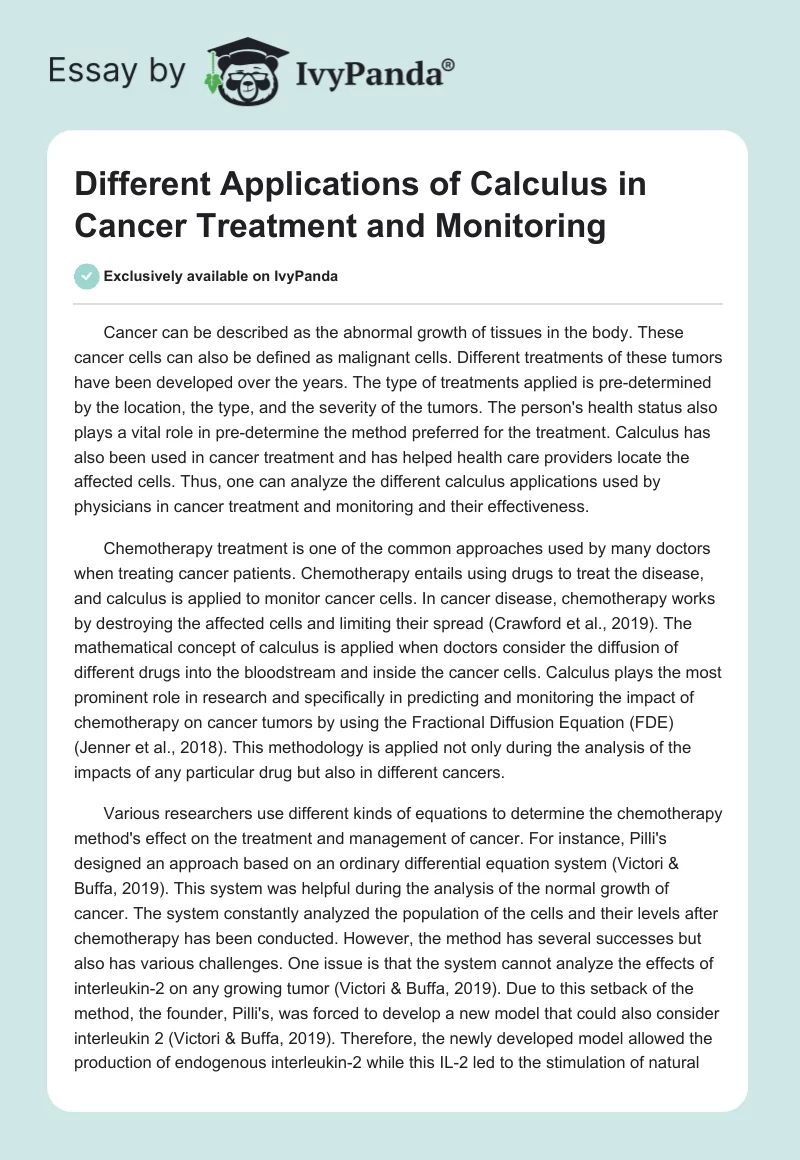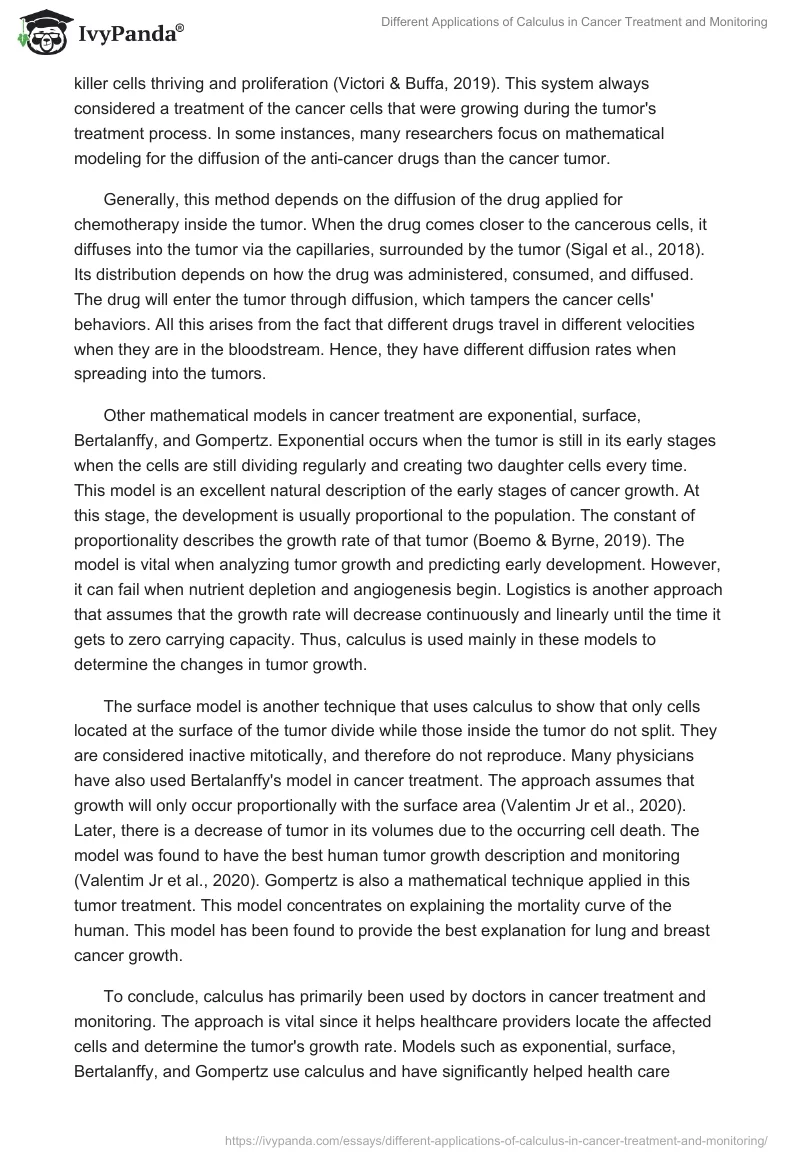Cancer can be described as the abnormal growth of tissues in the body. These cancer cells can also be defined as malignant cells. Different treatments of these tumors have been developed over the years. The type of treatments applied is pre-determined by the location, the type, and the severity of the tumors. The person’s health status also plays a vital role in pre-determine the method preferred for the treatment. Calculus has also been used in cancer treatment and has helped health care providers locate the affected cells. Thus, one can analyze the different calculus applications used by physicians in cancer treatment and monitoring and their effectiveness.
Chemotherapy treatment is one of the common approaches used by many doctors when treating cancer patients. Chemotherapy entails using drugs to treat the disease, and calculus is applied to monitor cancer cells. In cancer disease, chemotherapy works by destroying the affected cells and limiting their spread (Crawford et al., 2019). The mathematical concept of calculus is applied when doctors consider the diffusion of different drugs into the bloodstream and inside the cancer cells. Calculus plays the most prominent role in research and specifically in predicting and monitoring the impact of chemotherapy on cancer tumors by using the Fractional Diffusion Equation (FDE) (Jenner et al., 2018). This methodology is applied not only during the analysis of the impacts of any particular drug but also in different cancers.
Various researchers use different kinds of equations to determine the chemotherapy method’s effect on the treatment and management of cancer. For instance, Pilli’s designed an approach based on an ordinary differential equation system (Victori & Buffa, 2019). This system was helpful during the analysis of the normal growth of cancer. The system constantly analyzed the population of the cells and their levels after chemotherapy has been conducted. However, the method has several successes but also has various challenges. One issue is that the system cannot analyze the effects of interleukin-2 on any growing tumor (Victori & Buffa, 2019). Due to this setback of the method, the founder, Pilli’s, was forced to develop a new model that could also consider interleukin 2 (Victori & Buffa, 2019). Therefore, the newly developed model allowed the production of endogenous interleukin-2 while this IL-2 led to the stimulation of natural killer cells thriving and proliferation (Victori & Buffa, 2019). This system always considered a treatment of the cancer cells that were growing during the tumor’s treatment process. In some instances, many researchers focus on mathematical modeling for the diffusion of the anti-cancer drugs than the cancer tumor.
Generally, this method depends on the diffusion of the drug applied for chemotherapy inside the tumor. When the drug comes closer to the cancerous cells, it diffuses into the tumor via the capillaries, surrounded by the tumor (Sigal et al., 2018). Its distribution depends on how the drug was administered, consumed, and diffused. The drug will enter the tumor through diffusion, which tampers the cancer cells’ behaviors. All this arises from the fact that different drugs travel in different velocities when they are in the bloodstream. Hence, they have different diffusion rates when spreading into the tumors.
Other mathematical models in cancer treatment are exponential, surface, Bertalanffy, and Gompertz. Exponential occurs when the tumor is still in its early stages when the cells are still dividing regularly and creating two daughter cells every time. This model is an excellent natural description of the early stages of cancer growth. At this stage, the development is usually proportional to the population. The constant of proportionality describes the growth rate of that tumor (Boemo & Byrne, 2019). The model is vital when analyzing tumor growth and predicting early development. However, it can fail when nutrient depletion and angiogenesis begin. Logistics is another approach that assumes that the growth rate will decrease continuously and linearly until the time it gets to zero carrying capacity. Thus, calculus is used mainly in these models to determine the changes in tumor growth.
The surface model is another technique that uses calculus to show that only cells located at the surface of the tumor divide while those inside the tumor do not split. They are considered inactive mitotically, and therefore do not reproduce. Many physicians have also used Bertalanffy’s model in cancer treatment. The approach assumes that growth will only occur proportionally with the surface area (Valentim Jr et al., 2020). Later, there is a decrease of tumor in its volumes due to the occurring cell death. The model was found to have the best human tumor growth description and monitoring (Valentim Jr et al., 2020). Gompertz is also a mathematical technique applied in this tumor treatment. This model concentrates on explaining the mortality curve of the human. This model has been found to provide the best explanation for lung and breast cancer growth.
To conclude, calculus has primarily been used by doctors in cancer treatment and monitoring. The approach is vital since it helps healthcare providers locate the affected cells and determine the tumor’s growth rate. Models such as exponential, surface, Bertalanffy, and Gompertz use calculus and have significantly helped health care practitioners to treat patients with cancer. The approaches have also enabled medical practitioners to detect cancer cells early and ensure that condition is treated before it worsens. Therefore, there are different essential applications of calculus in cancer treatment and monitoring.
References
Boemo, M. A., & Byrne, H. M. (2019). Mathematical modeling of a hypoxia-regulated oncolytic virus delivered by tumor-associated macrophages. Journal of Theoretical Biology, 461(1), 102-116. Web.
Crawford, N., Salvucci, M., Hellwig, C. T., Lincoln, F. A., Mooney, R. E., O’Connor, C. L., & Rehm, M. (2018). Simulating and predicting cellular and in vivo responses of colon cancer to combined treatment with chemotherapy and IAP antagonist Birinapant/TL32711. Cell Death & Differentiation, 25(11), 1952-1966. Web.
Jenner, A. L., Yun, C. O., Kim, P. S., & Coster, A. C. (2018). Mathematical modeling of the interaction between cancer cells and an oncolytic virus: Insights into the effects of treatment protocols. Bulletin of Mathematical Biology, 80(6), 1615-1629. Web.
Sigal, D., Przedborski, M., Sivaloganathan, D., & Kohandel, M. (2019). Mathematical modeling of cancer stem cell-targeted immunotherapy. Mathematical Biosciences, 318(108269), 1-10. Web.
Valentim Jr, C. A., Oliveira, N. A., Rabi, J. A., & David, S. A. (2020). Can fractional calculus help improve tumor growth models? Journal of Computational and Applied Mathematics, 379(1), 1-5. Web.
Victori, P., & Buffa, F. M. (2019). The many faces of mathematical modeling in oncology. The British Journal of Radiology, 92(1093), 1-11. Web.


